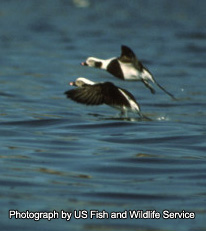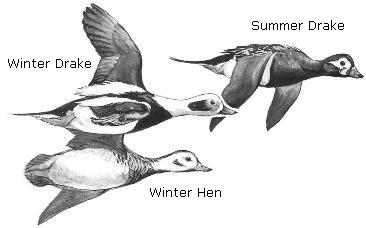Wildlife - Species

Species Specific Regulations
Long-Tailed Duck
Licenses: Hunting License required. Migratory Bird Hunting and Conservation Stamp (Federal Duck Stamp) that is validated by the hunter signing the stamp in ink across the face of the stamp
Limits: Please see Migratory Bird Regulations for any game zones restrictions or Limitations.
Long-Tailed Duck (Clanguta hyemalis)

Description
A slim, brightly plumaged sea duck. This duck is distinctive by its black head, gray face, black bill with punk band, and extremely long central tail feathers. Formerly referred to as "oldsquaw."
Average Size
Long-tailed ducks have an average length of 20 1/2 inches and an average weight of 2 pounds.
Range
Found in all four flyways, but most common along the coast. Long-tailed ducks are extremely rare winter visitors to South Carolina.
Preferred Habitat
During the summer months long-tailed ducks are found in subarctic and arctic wetlands and occasionally in tundra like habitats. In the winter they migrate to coastal marine waters and large freshwater lakes.
Food Habits
The diet of the long-tailed duck is highly variable across their range but is dominated by animal material. The main food on the breeding grounds consists of aquatic insects, crustaceans, fish roe and some vegetable matter. On marine wintering grounds they mainly consume crustaceans, while on freshwater wintering grounds fish, mollusks, and worms are important.
Reproduction
After mated pairs arrive on breeding grounds the female selects a nest site mainly on islands of ponds or on mainland tundra. The female creates a shallow depression lined in dried dwarf willow and dwarf birch and other plant material. She then lays 5-10 pale gray to olive eggs. .
Sound
Drakes have a loud pleasant caloo caloo, constantly heard. One of the most vocal ducks.
Behavior
- Flight is swift and low with constantly changing flock formations.
- Males are territorial on breeding grounds, although females will nest in groups outside of males territory.
- Found in small flocks during the winter months, will mix with other species.
Citations, Publications and Literature
U.S. Fish & Wildlife Service, Federal Duck Stamp Office Presents: North American Waterfowl (Adobe PDF file)
Robertson, Gregory J. and Jean-Pierre L. Savard. 2002. Long-tailed Duck (Clangula hyemalis), The Birds of North America Online (A. Poole, Ed.). Ithaca: Cornell Lab of Ornithology; Retrieved from the Birds of North America Online
South Carolina waterfowl hunters 16 and older are required by state law to obtain a state migratory waterfowl permit and Migratory Game Bird permit. Both permits must be in the hunter's possession while hunting or transporting legal waterfowl. A state waterfowl permit is included with the Lifetime Senior, Lifetime Gratis and Disability Licenses. S.C. residents who hold a Lifetime Senior or Lifetime Gratis License are not required to have a Migratory Game Bird permit.
National Migratory Bird Harvest Information Program (HIP)
The waterfowl permits and HIP permits are available from select DNR offices and from hunting and fishing license agents.
